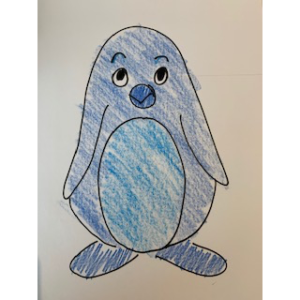Three Ways to Incorporate More Rigor and Relevance in Your Program


Last spring, I visited a kindergarten classroom. I took a seat in the back and looked on as quiet, obliging children filled in their spots at assigned seats. They stared ahead as the teacher wrote two sentences on a whiteboard (the “Morning Message”), and they responded in unison when asked to read the words aloud along with the teacher. The children then copied the sentences onto worksheets with two rows of primary-print lines.
The worksheets also included some math exercises—coloring in a prescribed number from a set of boxes and determining “How many?” pips were displayed on each of the two dominoes.
The children’s reward for completing the worksheet—before they moved on to writing more sentences from word walls and picture dictionaries–was that they were allowed to color the blackline image in the lower-right corner of the page. It was a picture of a penguin.
Did I mention it was May? In the northern hemisphere?
Why All Penguins Should Be Blue
The children, after what I know to have been months of practice, dutifully responded to the teacher’s instructions. In fact, they were so accustomed to this morning routine that they needed little guidance from the teacher. Without speaking, they copied the sentences and answered the math questions. Finally, they each colored the penguin. Many of them used only a black crayon—although a few also added orange to the beak—since representing the penguin’s white belly required nothing of them.
One child, however, colored his penguin blue. Top to bottom, side to side. All blue.
After watching the children work for a while, I stopped and talked to a child sitting next to the boy with the blue penguin. This child had colored his penguin in the traditional style. “Tell me about your penguin,” I said.

“Well,” he explained, “I saw a movie about penguins, so I know they are black and white with a little bit of orange.”
“I can tell you were really thinking about what you learned,” I said. Then I turned to the boy whose penguin was blue. “Tell me about your penguin,” I said.
“Well,” he whispered haltingly, “I saw a penguin movie, too. They live at the South Pole. It’s really cold there all the time, so I figured all the penguins who live there are cold, too. And when you want something in a cartoon to look cold, like ice, you color it blue.”
Yes. You’re right. You color things blue if you want them to look cold.
The child who dared to color his penguin something other than black and white had unwittingly ascended a few levels up Bloom’s Taxonomy.
I say “unwittingly” because all that was actually asked of him and his classmates by the morning’s assigned work was low-level thinking. Nothing about what was required of those children that morning was rigorous, despite the fact that all of it was required.
The child who displayed a more rigorous thought process was, in fact, the one whose “answer” may well have been considered “wrong.” While the other children displayed knowledge of what they remembered (a penguin is black and white, after all), this child had a synthesized understanding of concepts related to social studies, science, and art to create something new from something tedious: a penguin that looked cold.
Of course, I never would’ve realized all of this if I hadn’t spoken with the child—if I hadn’t posed an open-ended question that he could use to help me realize something important—that not only did this child have knowledge but that he was able to use it in a novel way.
As an administrator, you may or may not have a say in deciding the large-scale, long-term steps that ensure a more rigorous curriculum for the children in your program. But you most certainly have access to some simple steps you can take NOW, without having to wait for new funding or the next curriculum cycle or even a change in federal, state, and local requirements.
Here are some ideas for free or low-cost actions you (and the teachers) can take today to make sure you are leading a more rigorous learning experience for the children who come to your school each day to grow and develop and learn in your classrooms:
- Ask open-ended questions.
Ask children to explain their thinking. Ask them about their choices (a question we too often reserve for times when we as adults believe a child’s behavior represents a “poor choice”). Ask them what would happen if they changed one part. Added a part. Removed a part. Ask them what else they think they could use to display their knowledge, skills, and abilities. - Re-evaluate observation techniques
If you are a leader of an early childhood program or elementary school, I implore you to observe classrooms with an eye toward rigor. Ask yourself: What about this activity/interaction/learning experience I am seeing either supports the development of or represents current levels of children’s cognition? What about it demonstrates children’s ability to seek new knowledge, synthesize it with what they already know, and use it to create something new? When you talk with teachers about their plans, focus first on the verbs—what the children will be doing as they both learn and demonstrate their learning. What are the adults there doing to facilitate rigorous learning? What opportunities are they providing for children to engage in deep learning? What are they doing to foster deep thinking? What are they doing to provide opportunities for children to rigorously investigate topics that are relevant to their daily lives? The boy who colored his penguin blue had to find his own rigor because everything he and his classmates were being asked to do (copy sentences, identify quantities) was actually an obstacle standing in the way of creation, invention, collaboration, and connection. It may well have been the case that many more of the children in the class that day had knowledge and ideas about penguins, but since they were neither explicitly asked nor given opportunities to demonstrate that knowledge in a variety of ways, they simply and safely complied with what was asked of them, just as the teacher was probably complying with what was being asked of her. Let’s beware of what we ask of them because they just might give it to us. - Implement relevant learning experiences
Finally, if you find yourself asking, “Why was there a penguin there in the first place?” Well, I don’t have the answer to that. Nothing else about the worksheet had anything to do with penguins. Nothing else in the classroom had anything to do with penguins. It was May in the northern hemisphere, so, no, there were no penguins around anywhere. Not only was there no rigor; there was also no relevance.
What I can tell you is that not all penguins actually need to be colored blue. But for me, the blue penguin will forever serve as an example of what I can learn from a child. I encourage you to find your own “blue penguin” and let it guide your thinking, your conversations, and your decision making as you seek to lead teachers and learners towards a more rigorous early childhood experience.